MAC007A: Strategic Management Report on OTD Analysis
VerifiedAdded on 2023/01/18
|20
|4907
|90
Report
AI Summary
This report examines the strategic management of On Time Deliveries Ltd (OTD), a leading express courier company in Australia. It begins with an executive summary highlighting the application of the Balanced Scorecard (BSC) technique to assess OTD's performance, identify areas for improvement, and formulate strategies aligned with its goals. A BSC is developed, followed by a value chain analysis to evaluate value-added activities and associated costs, particularly focusing on areas impacting profitability like infrastructure and delivery expenses. The report then integrates the BSC with the SCSA technique, emphasizing the importance of CSA workshops in implementing the strategies. The analysis covers customer, financial, process, and learning & growth perspectives, providing insights into OTD's performance, cost efficiency, and strategic initiatives. The report includes Porter’s value chain model, a detailed look at the primary activities, and a discussion on the cost associated with the outbound logistics and marketing & sales activities.
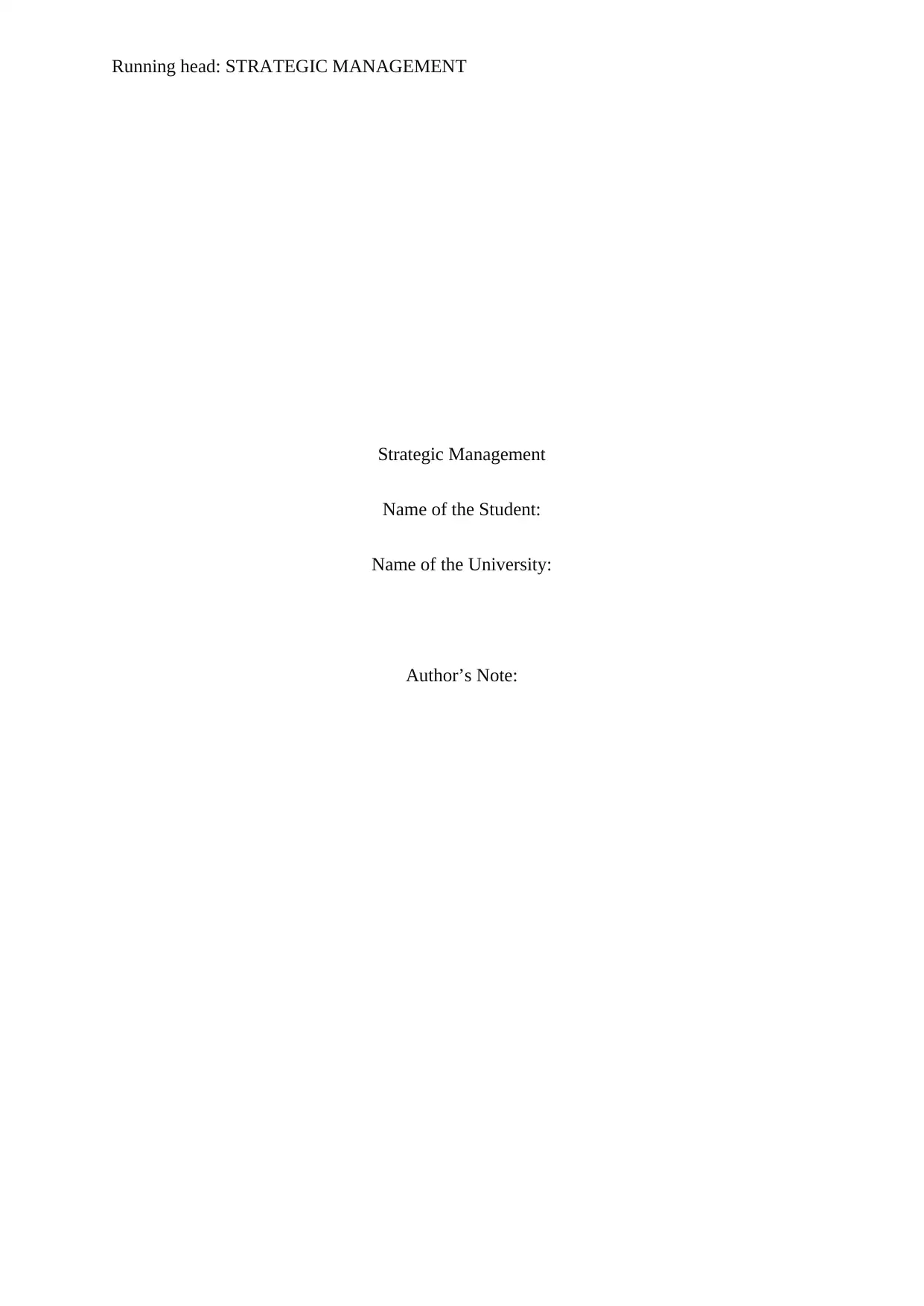
Running head: STRATEGIC MANAGEMENT
Strategic Management
Name of the Student:
Name of the University:
Author’s Note:
Strategic Management
Name of the Student:
Name of the University:
Author’s Note:
Paraphrase This Document
Need a fresh take? Get an instant paraphrase of this document with our AI Paraphraser
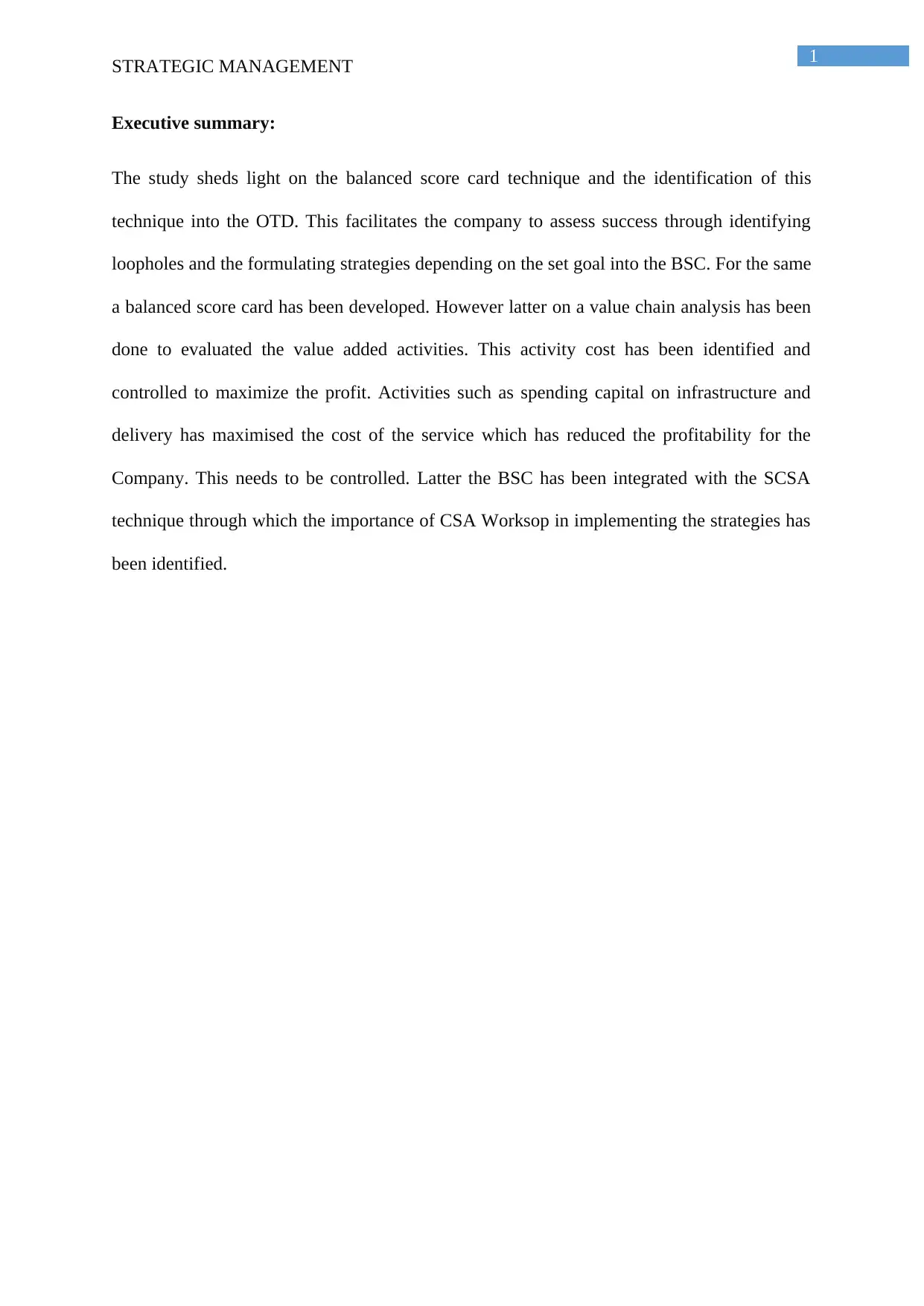
1
STRATEGIC MANAGEMENT
Executive summary:
The study sheds light on the balanced score card technique and the identification of this
technique into the OTD. This facilitates the company to assess success through identifying
loopholes and the formulating strategies depending on the set goal into the BSC. For the same
a balanced score card has been developed. However latter on a value chain analysis has been
done to evaluated the value added activities. This activity cost has been identified and
controlled to maximize the profit. Activities such as spending capital on infrastructure and
delivery has maximised the cost of the service which has reduced the profitability for the
Company. This needs to be controlled. Latter the BSC has been integrated with the SCSA
technique through which the importance of CSA Worksop in implementing the strategies has
been identified.
STRATEGIC MANAGEMENT
Executive summary:
The study sheds light on the balanced score card technique and the identification of this
technique into the OTD. This facilitates the company to assess success through identifying
loopholes and the formulating strategies depending on the set goal into the BSC. For the same
a balanced score card has been developed. However latter on a value chain analysis has been
done to evaluated the value added activities. This activity cost has been identified and
controlled to maximize the profit. Activities such as spending capital on infrastructure and
delivery has maximised the cost of the service which has reduced the profitability for the
Company. This needs to be controlled. Latter the BSC has been integrated with the SCSA
technique through which the importance of CSA Worksop in implementing the strategies has
been identified.
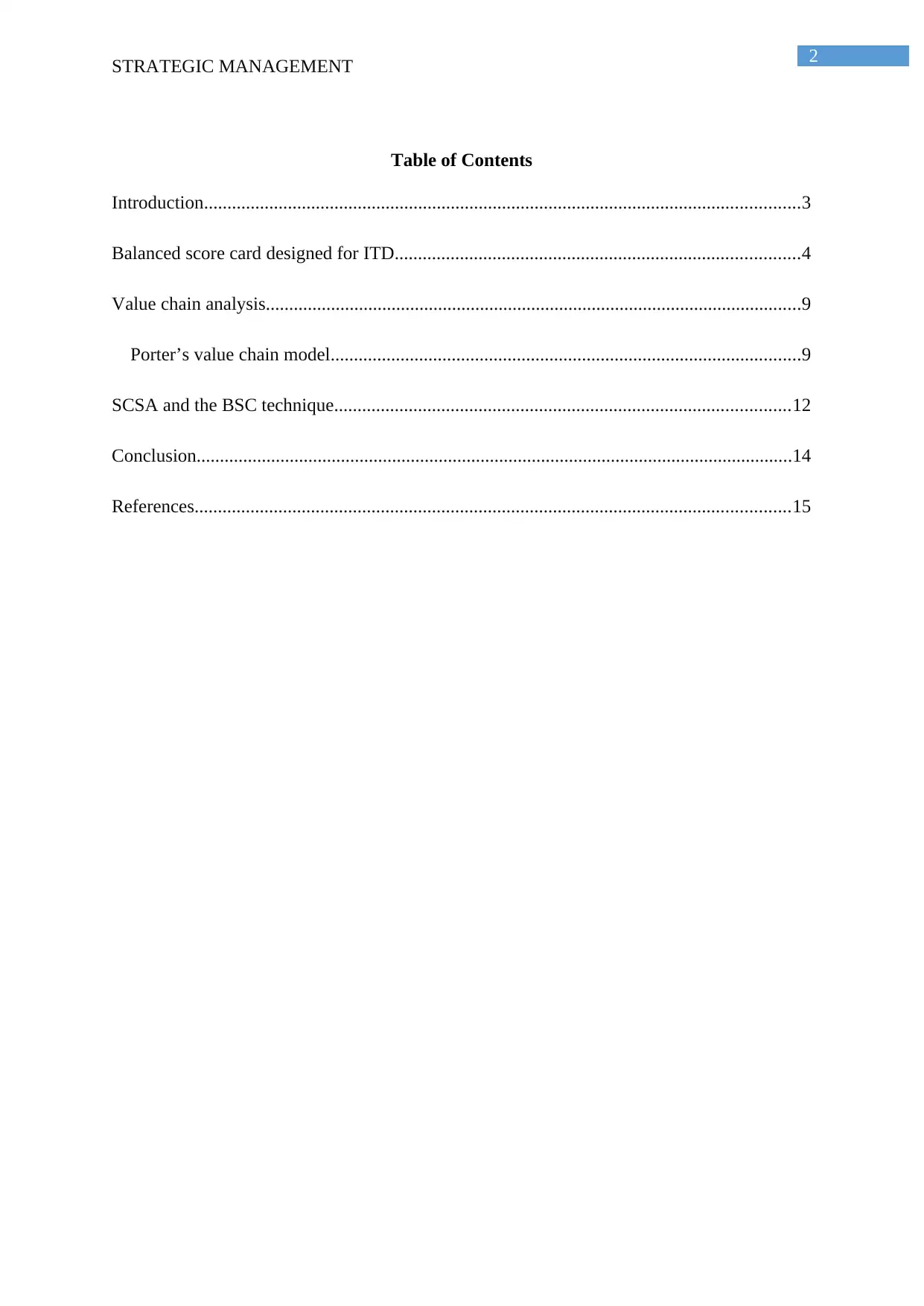
2
STRATEGIC MANAGEMENT
Table of Contents
Introduction................................................................................................................................3
Balanced score card designed for ITD.......................................................................................4
Value chain analysis...................................................................................................................9
Porter’s value chain model.....................................................................................................9
SCSA and the BSC technique..................................................................................................12
Conclusion................................................................................................................................14
References................................................................................................................................15
STRATEGIC MANAGEMENT
Table of Contents
Introduction................................................................................................................................3
Balanced score card designed for ITD.......................................................................................4
Value chain analysis...................................................................................................................9
Porter’s value chain model.....................................................................................................9
SCSA and the BSC technique..................................................................................................12
Conclusion................................................................................................................................14
References................................................................................................................................15
⊘ This is a preview!⊘
Do you want full access?
Subscribe today to unlock all pages.

Trusted by 1+ million students worldwide
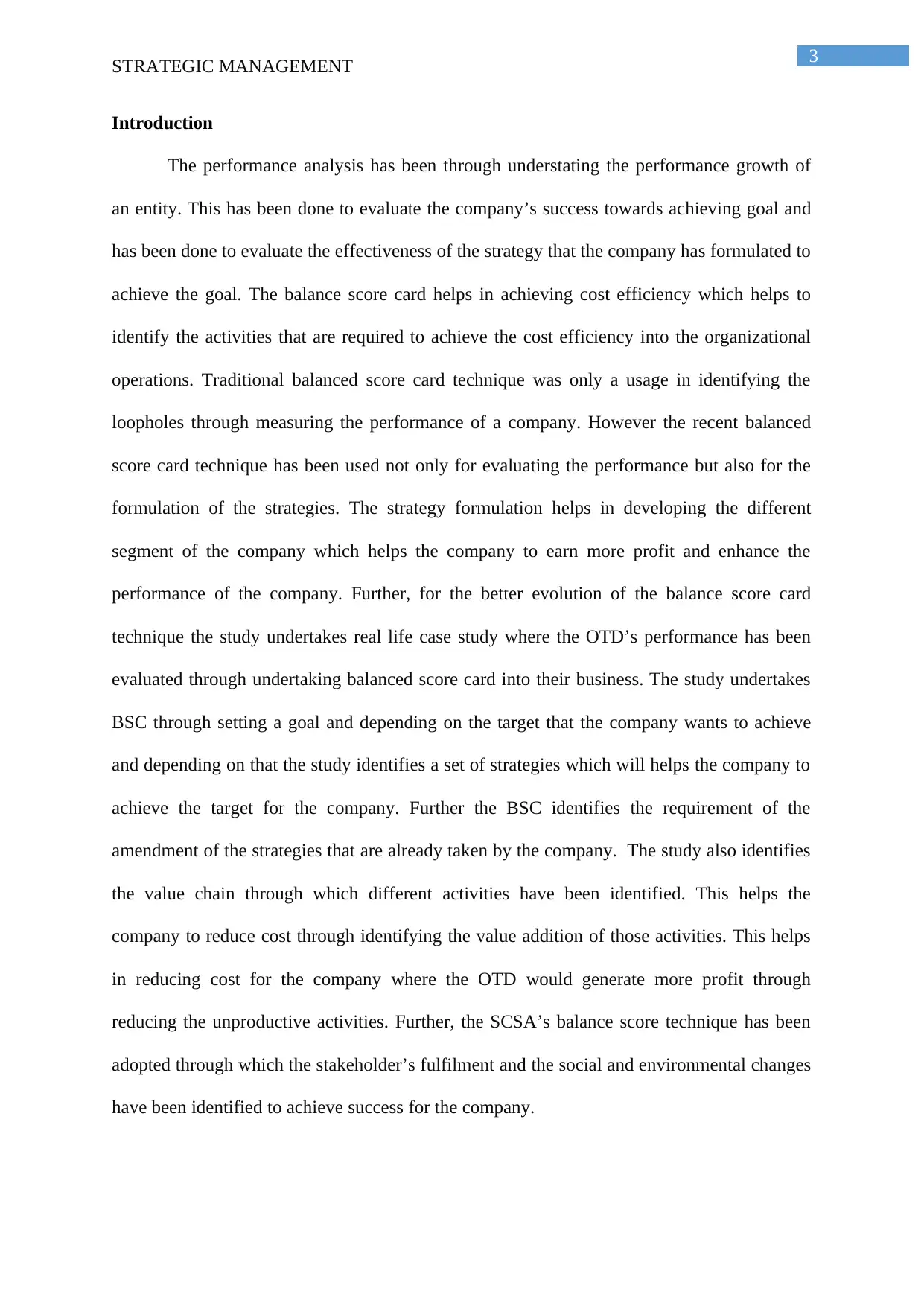
3
STRATEGIC MANAGEMENT
Introduction
The performance analysis has been through understating the performance growth of
an entity. This has been done to evaluate the company’s success towards achieving goal and
has been done to evaluate the effectiveness of the strategy that the company has formulated to
achieve the goal. The balance score card helps in achieving cost efficiency which helps to
identify the activities that are required to achieve the cost efficiency into the organizational
operations. Traditional balanced score card technique was only a usage in identifying the
loopholes through measuring the performance of a company. However the recent balanced
score card technique has been used not only for evaluating the performance but also for the
formulation of the strategies. The strategy formulation helps in developing the different
segment of the company which helps the company to earn more profit and enhance the
performance of the company. Further, for the better evolution of the balance score card
technique the study undertakes real life case study where the OTD’s performance has been
evaluated through undertaking balanced score card into their business. The study undertakes
BSC through setting a goal and depending on the target that the company wants to achieve
and depending on that the study identifies a set of strategies which will helps the company to
achieve the target for the company. Further the BSC identifies the requirement of the
amendment of the strategies that are already taken by the company. The study also identifies
the value chain through which different activities have been identified. This helps the
company to reduce cost through identifying the value addition of those activities. This helps
in reducing cost for the company where the OTD would generate more profit through
reducing the unproductive activities. Further, the SCSA’s balance score technique has been
adopted through which the stakeholder’s fulfilment and the social and environmental changes
have been identified to achieve success for the company.
STRATEGIC MANAGEMENT
Introduction
The performance analysis has been through understating the performance growth of
an entity. This has been done to evaluate the company’s success towards achieving goal and
has been done to evaluate the effectiveness of the strategy that the company has formulated to
achieve the goal. The balance score card helps in achieving cost efficiency which helps to
identify the activities that are required to achieve the cost efficiency into the organizational
operations. Traditional balanced score card technique was only a usage in identifying the
loopholes through measuring the performance of a company. However the recent balanced
score card technique has been used not only for evaluating the performance but also for the
formulation of the strategies. The strategy formulation helps in developing the different
segment of the company which helps the company to earn more profit and enhance the
performance of the company. Further, for the better evolution of the balance score card
technique the study undertakes real life case study where the OTD’s performance has been
evaluated through undertaking balanced score card into their business. The study undertakes
BSC through setting a goal and depending on the target that the company wants to achieve
and depending on that the study identifies a set of strategies which will helps the company to
achieve the target for the company. Further the BSC identifies the requirement of the
amendment of the strategies that are already taken by the company. The study also identifies
the value chain through which different activities have been identified. This helps the
company to reduce cost through identifying the value addition of those activities. This helps
in reducing cost for the company where the OTD would generate more profit through
reducing the unproductive activities. Further, the SCSA’s balance score technique has been
adopted through which the stakeholder’s fulfilment and the social and environmental changes
have been identified to achieve success for the company.
Paraphrase This Document
Need a fresh take? Get an instant paraphrase of this document with our AI Paraphraser
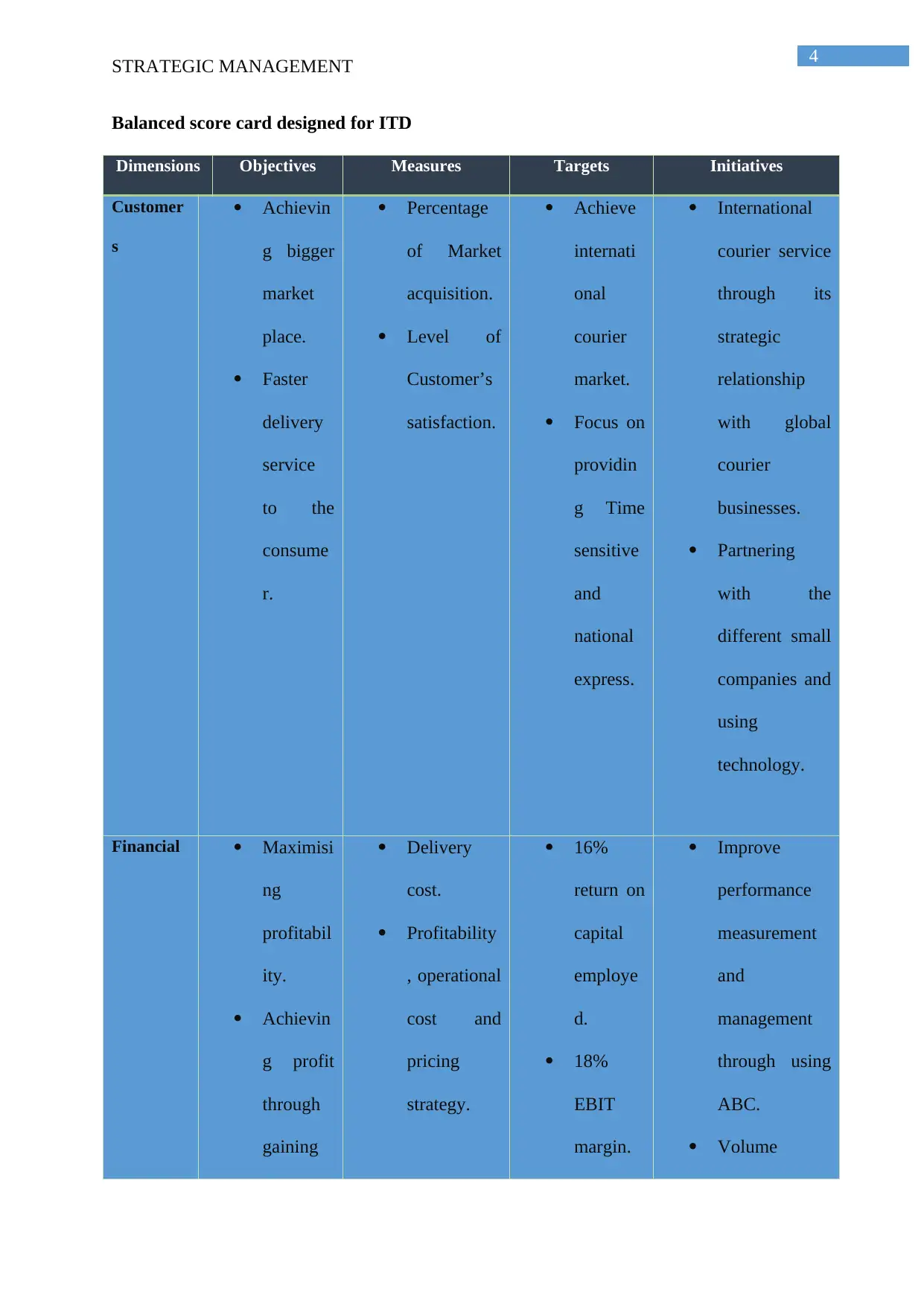
4
STRATEGIC MANAGEMENT
Balanced score card designed for ITD
Dimensions Objectives Measures Targets Initiatives
Customer
s
Achievin
g bigger
market
place.
Faster
delivery
service
to the
consume
r.
Percentage
of Market
acquisition.
Level of
Customer’s
satisfaction.
Achieve
internati
onal
courier
market.
Focus on
providin
g Time
sensitive
and
national
express.
International
courier service
through its
strategic
relationship
with global
courier
businesses.
Partnering
with the
different small
companies and
using
technology.
Financial Maximisi
ng
profitabil
ity.
Achievin
g profit
through
gaining
Delivery
cost.
Profitability
, operational
cost and
pricing
strategy.
16%
return on
capital
employe
d.
18%
EBIT
margin.
Improve
performance
measurement
and
management
through using
ABC.
Volume
STRATEGIC MANAGEMENT
Balanced score card designed for ITD
Dimensions Objectives Measures Targets Initiatives
Customer
s
Achievin
g bigger
market
place.
Faster
delivery
service
to the
consume
r.
Percentage
of Market
acquisition.
Level of
Customer’s
satisfaction.
Achieve
internati
onal
courier
market.
Focus on
providin
g Time
sensitive
and
national
express.
International
courier service
through its
strategic
relationship
with global
courier
businesses.
Partnering
with the
different small
companies and
using
technology.
Financial Maximisi
ng
profitabil
ity.
Achievin
g profit
through
gaining
Delivery
cost.
Profitability
, operational
cost and
pricing
strategy.
16%
return on
capital
employe
d.
18%
EBIT
margin.
Improve
performance
measurement
and
management
through using
ABC.
Volume
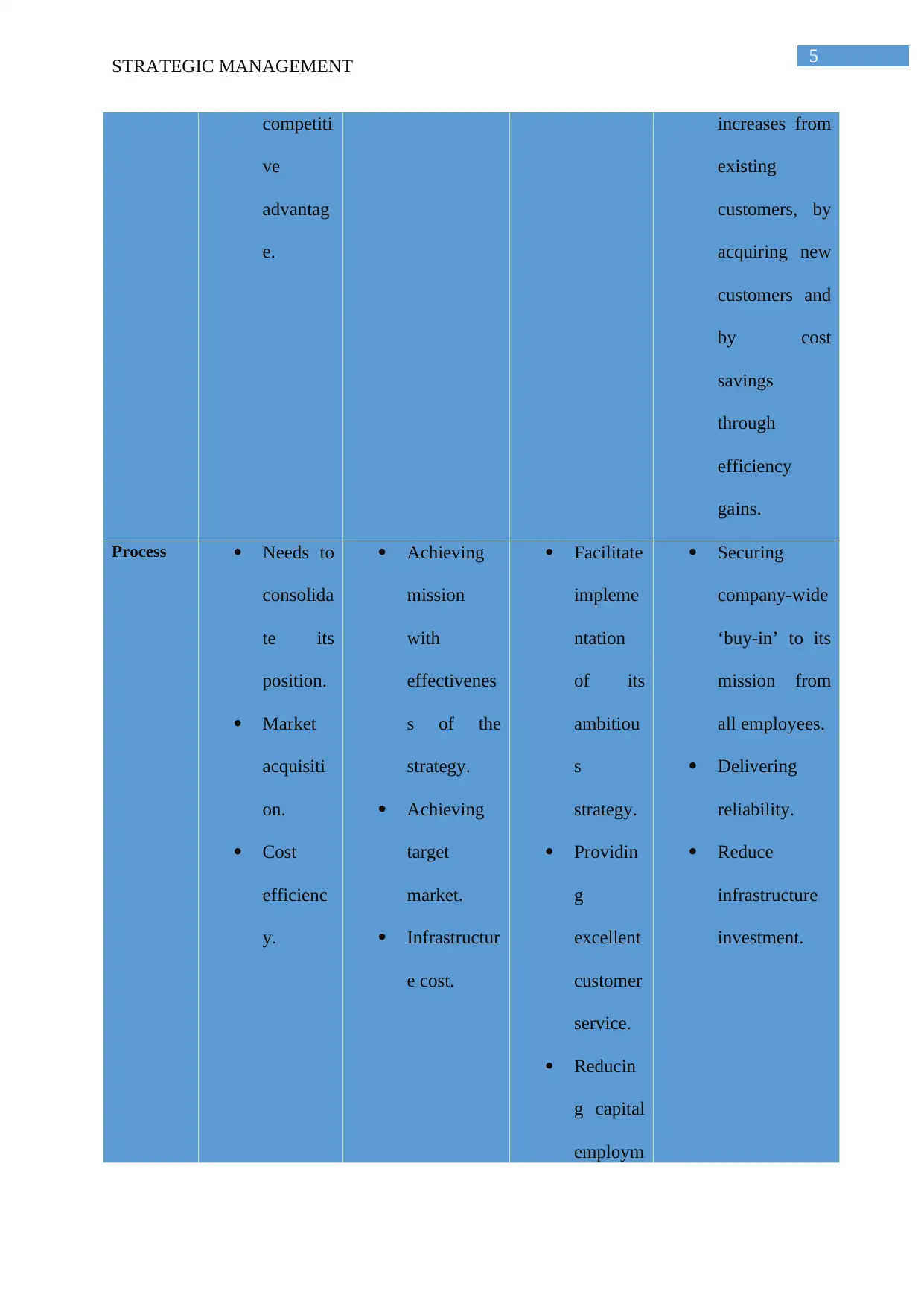
5
STRATEGIC MANAGEMENT
competiti
ve
advantag
e.
increases from
existing
customers, by
acquiring new
customers and
by cost
savings
through
efficiency
gains.
Process Needs to
consolida
te its
position.
Market
acquisiti
on.
Cost
efficienc
y.
Achieving
mission
with
effectivenes
s of the
strategy.
Achieving
target
market.
Infrastructur
e cost.
Facilitate
impleme
ntation
of its
ambitiou
s
strategy.
Providin
g
excellent
customer
service.
Reducin
g capital
employm
Securing
company-wide
‘buy-in’ to its
mission from
all employees.
Delivering
reliability.
Reduce
infrastructure
investment.
STRATEGIC MANAGEMENT
competiti
ve
advantag
e.
increases from
existing
customers, by
acquiring new
customers and
by cost
savings
through
efficiency
gains.
Process Needs to
consolida
te its
position.
Market
acquisiti
on.
Cost
efficienc
y.
Achieving
mission
with
effectivenes
s of the
strategy.
Achieving
target
market.
Infrastructur
e cost.
Facilitate
impleme
ntation
of its
ambitiou
s
strategy.
Providin
g
excellent
customer
service.
Reducin
g capital
employm
Securing
company-wide
‘buy-in’ to its
mission from
all employees.
Delivering
reliability.
Reduce
infrastructure
investment.
⊘ This is a preview!⊘
Do you want full access?
Subscribe today to unlock all pages.

Trusted by 1+ million students worldwide
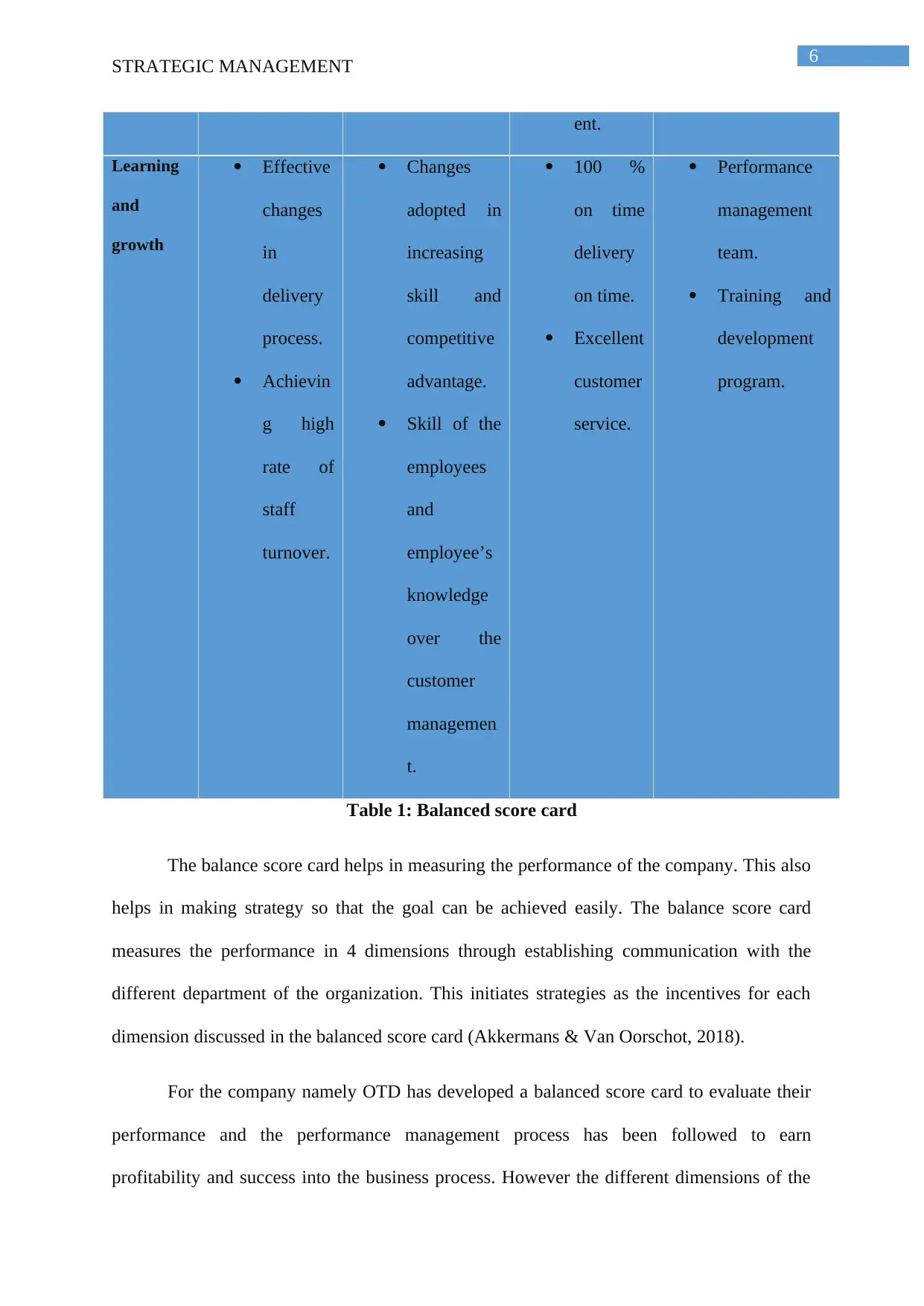
6
STRATEGIC MANAGEMENT
ent.
Learning
and
growth
Effective
changes
in
delivery
process.
Achievin
g high
rate of
staff
turnover.
Changes
adopted in
increasing
skill and
competitive
advantage.
Skill of the
employees
and
employee’s
knowledge
over the
customer
managemen
t.
100 %
on time
delivery
on time.
Excellent
customer
service.
Performance
management
team.
Training and
development
program.
Table 1: Balanced score card
The balance score card helps in measuring the performance of the company. This also
helps in making strategy so that the goal can be achieved easily. The balance score card
measures the performance in 4 dimensions through establishing communication with the
different department of the organization. This initiates strategies as the incentives for each
dimension discussed in the balanced score card (Akkermans & Van Oorschot, 2018).
For the company namely OTD has developed a balanced score card to evaluate their
performance and the performance management process has been followed to earn
profitability and success into the business process. However the different dimensions of the
STRATEGIC MANAGEMENT
ent.
Learning
and
growth
Effective
changes
in
delivery
process.
Achievin
g high
rate of
staff
turnover.
Changes
adopted in
increasing
skill and
competitive
advantage.
Skill of the
employees
and
employee’s
knowledge
over the
customer
managemen
t.
100 %
on time
delivery
on time.
Excellent
customer
service.
Performance
management
team.
Training and
development
program.
Table 1: Balanced score card
The balance score card helps in measuring the performance of the company. This also
helps in making strategy so that the goal can be achieved easily. The balance score card
measures the performance in 4 dimensions through establishing communication with the
different department of the organization. This initiates strategies as the incentives for each
dimension discussed in the balanced score card (Akkermans & Van Oorschot, 2018).
For the company namely OTD has developed a balanced score card to evaluate their
performance and the performance management process has been followed to earn
profitability and success into the business process. However the different dimensions of the
Paraphrase This Document
Need a fresh take? Get an instant paraphrase of this document with our AI Paraphraser

7
STRATEGIC MANAGEMENT
company have been evaluated to understand the requirement of the strategy formation (Kang
et al., 2015). This has also provided idea on the measurement of their performance. Below
has provided on the performance evaluation on the BSC:
Customer prospective: The customer prospective defines the measurement of the company’s
performance in achieving customer’s and customers’ satisfaction (Tjader et al., 2014). This
also measures the market acquisition through measuring the customers that have been
achieved into new market segment. This has been noticed that the company has made
strategy to achieve international courier market. The target has been formulated to generate
customer satisfaction through providing time sensitive and national express (Hill& Brierley,
2017). For this the company has suggested to adopt international courier service through its
strategic relationship with the global courier business. Further for generating customer
satisfaction the company set on generating faster courier delivery. For this the company has
planned to use technology to reduce the delivery cost (Bel, G., & Warner, 2016).
Financial prospective: the company has recently not earned their return on investment as
desired. The company also are reduced with their EBIT. This happens as the company
realises an increase into the infrastructure cost and the operational cost (Narimani et al.,
2014). Through the balanced score card technique the company identifies the loopholes as the
strategic disability. The BSC measures financial performance through evaluating return on
investment and the profit earned during a period. However depending on this the BSC
formulates strategy to meet with the set target of the company. The target has been set at 16
% return on capital employment. For this the company has taken initiative towards improving
performance measurement and the management through using activity based costing. Into the
financial dimension the BSC measures the profitability of the company’s activity. To earn
more profit the company sets their target of earning 18% EBIT margin. For this the strategy
STRATEGIC MANAGEMENT
company have been evaluated to understand the requirement of the strategy formation (Kang
et al., 2015). This has also provided idea on the measurement of their performance. Below
has provided on the performance evaluation on the BSC:
Customer prospective: The customer prospective defines the measurement of the company’s
performance in achieving customer’s and customers’ satisfaction (Tjader et al., 2014). This
also measures the market acquisition through measuring the customers that have been
achieved into new market segment. This has been noticed that the company has made
strategy to achieve international courier market. The target has been formulated to generate
customer satisfaction through providing time sensitive and national express (Hill& Brierley,
2017). For this the company has suggested to adopt international courier service through its
strategic relationship with the global courier business. Further for generating customer
satisfaction the company set on generating faster courier delivery. For this the company has
planned to use technology to reduce the delivery cost (Bel, G., & Warner, 2016).
Financial prospective: the company has recently not earned their return on investment as
desired. The company also are reduced with their EBIT. This happens as the company
realises an increase into the infrastructure cost and the operational cost (Narimani et al.,
2014). Through the balanced score card technique the company identifies the loopholes as the
strategic disability. The BSC measures financial performance through evaluating return on
investment and the profit earned during a period. However depending on this the BSC
formulates strategy to meet with the set target of the company. The target has been set at 16
% return on capital employment. For this the company has taken initiative towards improving
performance measurement and the management through using activity based costing. Into the
financial dimension the BSC measures the profitability of the company’s activity. To earn
more profit the company sets their target of earning 18% EBIT margin. For this the strategy
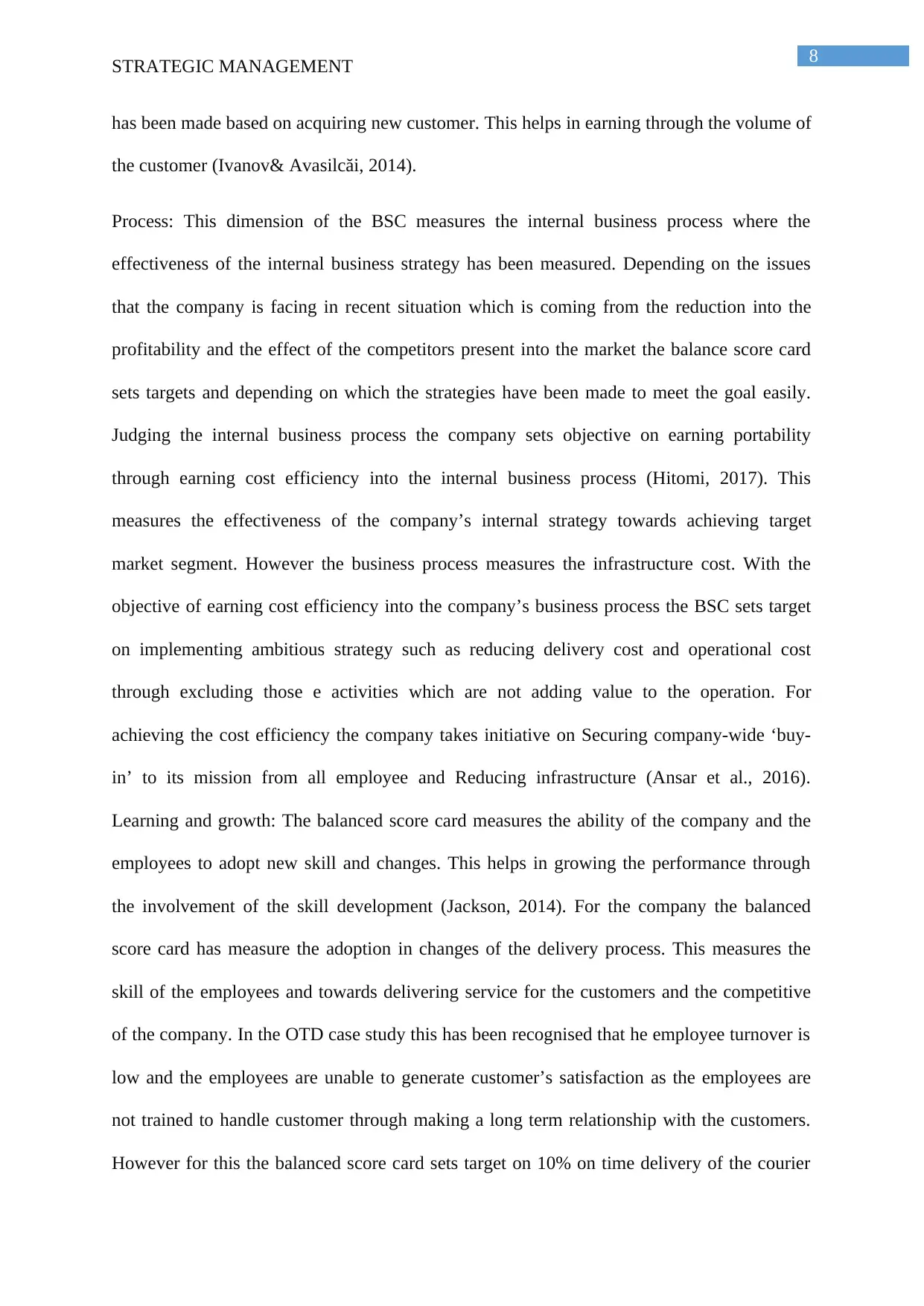
8
STRATEGIC MANAGEMENT
has been made based on acquiring new customer. This helps in earning through the volume of
the customer (Ivanov& Avasilcăi, 2014).
Process: This dimension of the BSC measures the internal business process where the
effectiveness of the internal business strategy has been measured. Depending on the issues
that the company is facing in recent situation which is coming from the reduction into the
profitability and the effect of the competitors present into the market the balance score card
sets targets and depending on which the strategies have been made to meet the goal easily.
Judging the internal business process the company sets objective on earning portability
through earning cost efficiency into the internal business process (Hitomi, 2017). This
measures the effectiveness of the company’s internal strategy towards achieving target
market segment. However the business process measures the infrastructure cost. With the
objective of earning cost efficiency into the company’s business process the BSC sets target
on implementing ambitious strategy such as reducing delivery cost and operational cost
through excluding those e activities which are not adding value to the operation. For
achieving the cost efficiency the company takes initiative on Securing company-wide ‘buy-
in’ to its mission from all employee and Reducing infrastructure (Ansar et al., 2016).
Learning and growth: The balanced score card measures the ability of the company and the
employees to adopt new skill and changes. This helps in growing the performance through
the involvement of the skill development (Jackson, 2014). For the company the balanced
score card has measure the adoption in changes of the delivery process. This measures the
skill of the employees and towards delivering service for the customers and the competitive
of the company. In the OTD case study this has been recognised that he employee turnover is
low and the employees are unable to generate customer’s satisfaction as the employees are
not trained to handle customer through making a long term relationship with the customers.
However for this the balanced score card sets target on 10% on time delivery of the courier
STRATEGIC MANAGEMENT
has been made based on acquiring new customer. This helps in earning through the volume of
the customer (Ivanov& Avasilcăi, 2014).
Process: This dimension of the BSC measures the internal business process where the
effectiveness of the internal business strategy has been measured. Depending on the issues
that the company is facing in recent situation which is coming from the reduction into the
profitability and the effect of the competitors present into the market the balance score card
sets targets and depending on which the strategies have been made to meet the goal easily.
Judging the internal business process the company sets objective on earning portability
through earning cost efficiency into the internal business process (Hitomi, 2017). This
measures the effectiveness of the company’s internal strategy towards achieving target
market segment. However the business process measures the infrastructure cost. With the
objective of earning cost efficiency into the company’s business process the BSC sets target
on implementing ambitious strategy such as reducing delivery cost and operational cost
through excluding those e activities which are not adding value to the operation. For
achieving the cost efficiency the company takes initiative on Securing company-wide ‘buy-
in’ to its mission from all employee and Reducing infrastructure (Ansar et al., 2016).
Learning and growth: The balanced score card measures the ability of the company and the
employees to adopt new skill and changes. This helps in growing the performance through
the involvement of the skill development (Jackson, 2014). For the company the balanced
score card has measure the adoption in changes of the delivery process. This measures the
skill of the employees and towards delivering service for the customers and the competitive
of the company. In the OTD case study this has been recognised that he employee turnover is
low and the employees are unable to generate customer’s satisfaction as the employees are
not trained to handle customer through making a long term relationship with the customers.
However for this the balanced score card sets target on 10% on time delivery of the courier
⊘ This is a preview!⊘
Do you want full access?
Subscribe today to unlock all pages.

Trusted by 1+ million students worldwide
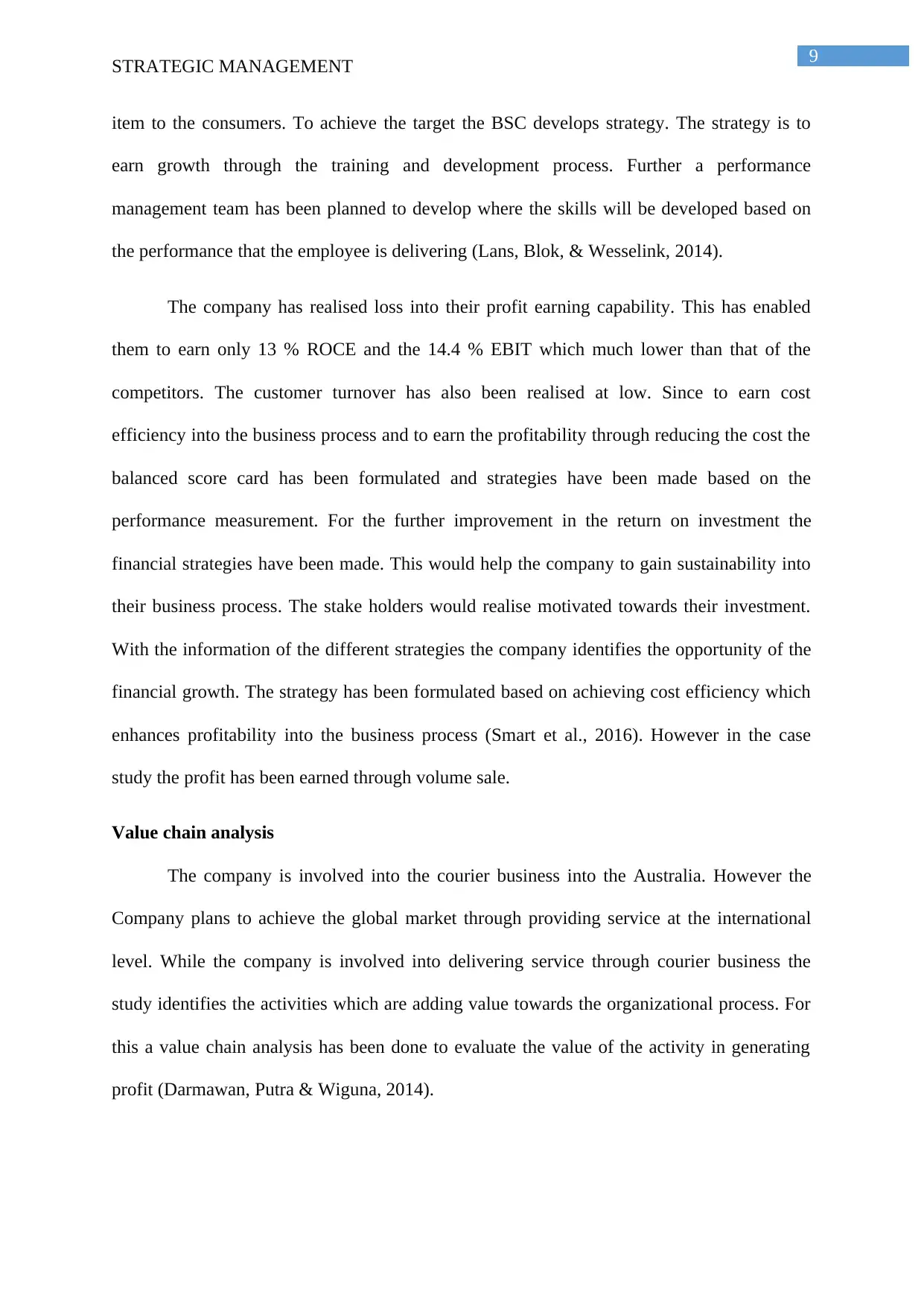
9
STRATEGIC MANAGEMENT
item to the consumers. To achieve the target the BSC develops strategy. The strategy is to
earn growth through the training and development process. Further a performance
management team has been planned to develop where the skills will be developed based on
the performance that the employee is delivering (Lans, Blok, & Wesselink, 2014).
The company has realised loss into their profit earning capability. This has enabled
them to earn only 13 % ROCE and the 14.4 % EBIT which much lower than that of the
competitors. The customer turnover has also been realised at low. Since to earn cost
efficiency into the business process and to earn the profitability through reducing the cost the
balanced score card has been formulated and strategies have been made based on the
performance measurement. For the further improvement in the return on investment the
financial strategies have been made. This would help the company to gain sustainability into
their business process. The stake holders would realise motivated towards their investment.
With the information of the different strategies the company identifies the opportunity of the
financial growth. The strategy has been formulated based on achieving cost efficiency which
enhances profitability into the business process (Smart et al., 2016). However in the case
study the profit has been earned through volume sale.
Value chain analysis
The company is involved into the courier business into the Australia. However the
Company plans to achieve the global market through providing service at the international
level. While the company is involved into delivering service through courier business the
study identifies the activities which are adding value towards the organizational process. For
this a value chain analysis has been done to evaluate the value of the activity in generating
profit (Darmawan, Putra & Wiguna, 2014).
STRATEGIC MANAGEMENT
item to the consumers. To achieve the target the BSC develops strategy. The strategy is to
earn growth through the training and development process. Further a performance
management team has been planned to develop where the skills will be developed based on
the performance that the employee is delivering (Lans, Blok, & Wesselink, 2014).
The company has realised loss into their profit earning capability. This has enabled
them to earn only 13 % ROCE and the 14.4 % EBIT which much lower than that of the
competitors. The customer turnover has also been realised at low. Since to earn cost
efficiency into the business process and to earn the profitability through reducing the cost the
balanced score card has been formulated and strategies have been made based on the
performance measurement. For the further improvement in the return on investment the
financial strategies have been made. This would help the company to gain sustainability into
their business process. The stake holders would realise motivated towards their investment.
With the information of the different strategies the company identifies the opportunity of the
financial growth. The strategy has been formulated based on achieving cost efficiency which
enhances profitability into the business process (Smart et al., 2016). However in the case
study the profit has been earned through volume sale.
Value chain analysis
The company is involved into the courier business into the Australia. However the
Company plans to achieve the global market through providing service at the international
level. While the company is involved into delivering service through courier business the
study identifies the activities which are adding value towards the organizational process. For
this a value chain analysis has been done to evaluate the value of the activity in generating
profit (Darmawan, Putra & Wiguna, 2014).
Paraphrase This Document
Need a fresh take? Get an instant paraphrase of this document with our AI Paraphraser
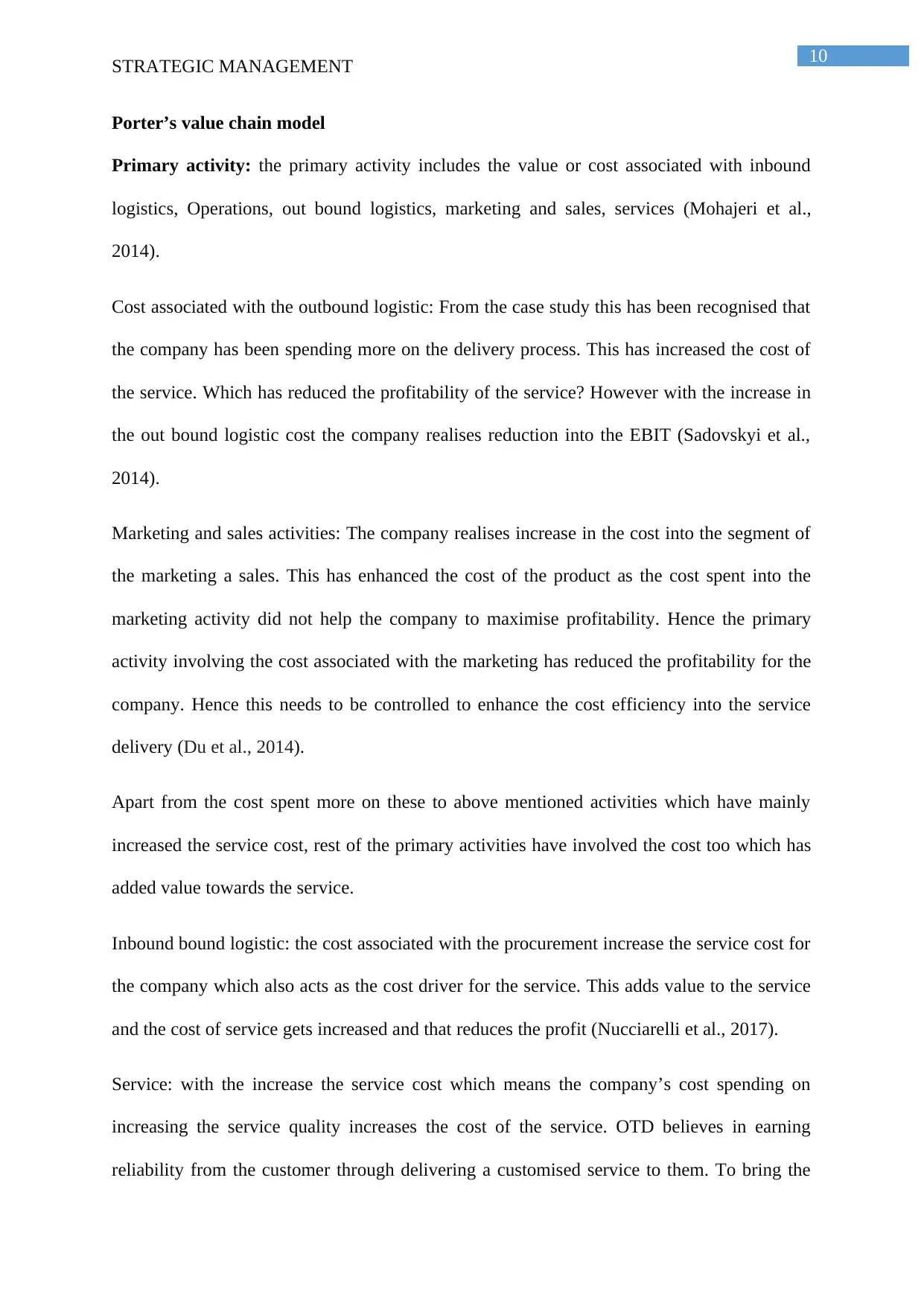
10
STRATEGIC MANAGEMENT
Porter’s value chain model
Primary activity: the primary activity includes the value or cost associated with inbound
logistics, Operations, out bound logistics, marketing and sales, services (Mohajeri et al.,
2014).
Cost associated with the outbound logistic: From the case study this has been recognised that
the company has been spending more on the delivery process. This has increased the cost of
the service. Which has reduced the profitability of the service? However with the increase in
the out bound logistic cost the company realises reduction into the EBIT (Sadovskyi et al.,
2014).
Marketing and sales activities: The company realises increase in the cost into the segment of
the marketing a sales. This has enhanced the cost of the product as the cost spent into the
marketing activity did not help the company to maximise profitability. Hence the primary
activity involving the cost associated with the marketing has reduced the profitability for the
company. Hence this needs to be controlled to enhance the cost efficiency into the service
delivery (Du et al., 2014).
Apart from the cost spent more on these to above mentioned activities which have mainly
increased the service cost, rest of the primary activities have involved the cost too which has
added value towards the service.
Inbound bound logistic: the cost associated with the procurement increase the service cost for
the company which also acts as the cost driver for the service. This adds value to the service
and the cost of service gets increased and that reduces the profit (Nucciarelli et al., 2017).
Service: with the increase the service cost which means the company’s cost spending on
increasing the service quality increases the cost of the service. OTD believes in earning
reliability from the customer through delivering a customised service to them. To bring the
STRATEGIC MANAGEMENT
Porter’s value chain model
Primary activity: the primary activity includes the value or cost associated with inbound
logistics, Operations, out bound logistics, marketing and sales, services (Mohajeri et al.,
2014).
Cost associated with the outbound logistic: From the case study this has been recognised that
the company has been spending more on the delivery process. This has increased the cost of
the service. Which has reduced the profitability of the service? However with the increase in
the out bound logistic cost the company realises reduction into the EBIT (Sadovskyi et al.,
2014).
Marketing and sales activities: The company realises increase in the cost into the segment of
the marketing a sales. This has enhanced the cost of the product as the cost spent into the
marketing activity did not help the company to maximise profitability. Hence the primary
activity involving the cost associated with the marketing has reduced the profitability for the
company. Hence this needs to be controlled to enhance the cost efficiency into the service
delivery (Du et al., 2014).
Apart from the cost spent more on these to above mentioned activities which have mainly
increased the service cost, rest of the primary activities have involved the cost too which has
added value towards the service.
Inbound bound logistic: the cost associated with the procurement increase the service cost for
the company which also acts as the cost driver for the service. This adds value to the service
and the cost of service gets increased and that reduces the profit (Nucciarelli et al., 2017).
Service: with the increase the service cost which means the company’s cost spending on
increasing the service quality increases the cost of the service. OTD believes in earning
reliability from the customer through delivering a customised service to them. To bring the
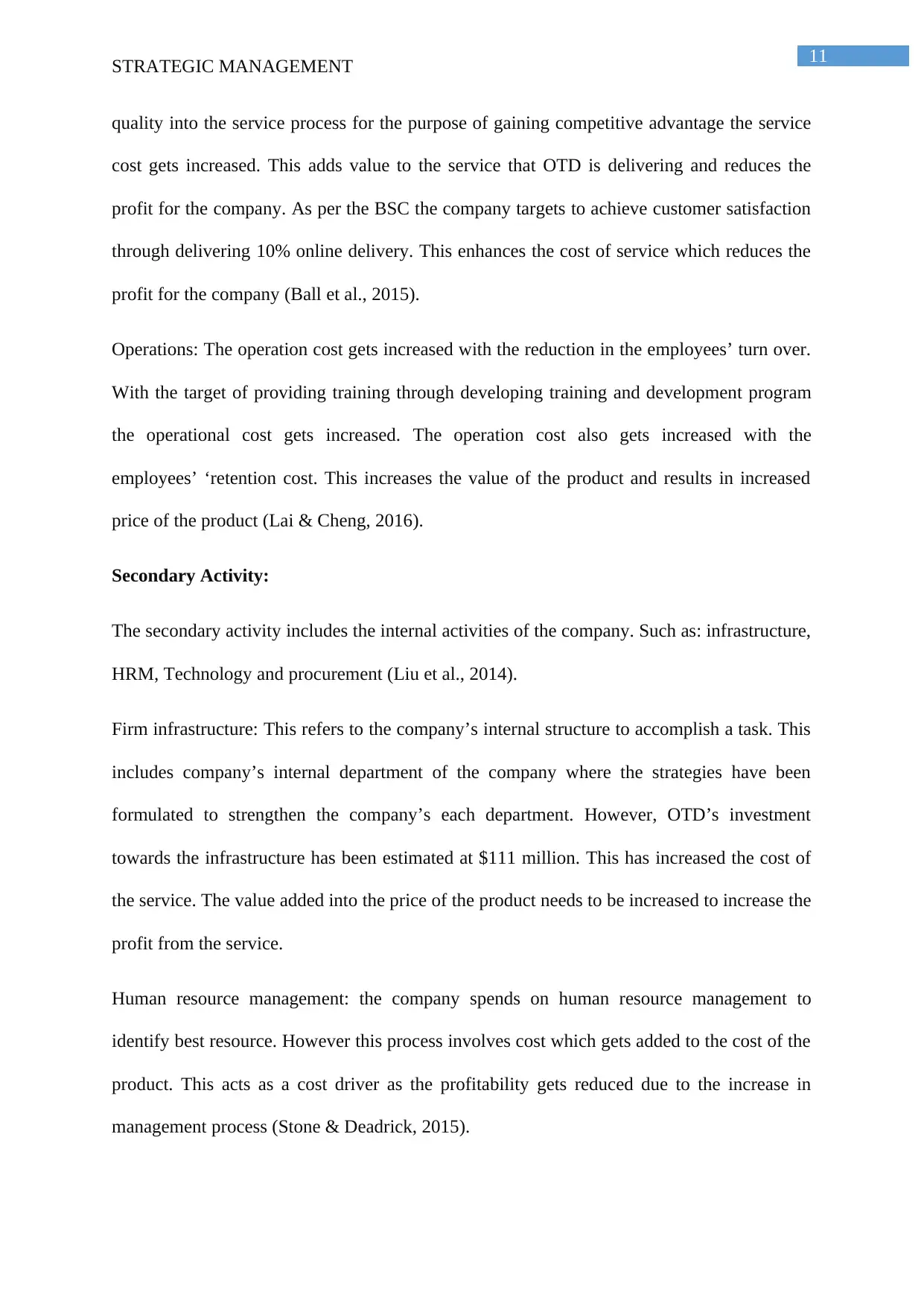
11
STRATEGIC MANAGEMENT
quality into the service process for the purpose of gaining competitive advantage the service
cost gets increased. This adds value to the service that OTD is delivering and reduces the
profit for the company. As per the BSC the company targets to achieve customer satisfaction
through delivering 10% online delivery. This enhances the cost of service which reduces the
profit for the company (Ball et al., 2015).
Operations: The operation cost gets increased with the reduction in the employees’ turn over.
With the target of providing training through developing training and development program
the operational cost gets increased. The operation cost also gets increased with the
employees’ ‘retention cost. This increases the value of the product and results in increased
price of the product (Lai & Cheng, 2016).
Secondary Activity:
The secondary activity includes the internal activities of the company. Such as: infrastructure,
HRM, Technology and procurement (Liu et al., 2014).
Firm infrastructure: This refers to the company’s internal structure to accomplish a task. This
includes company’s internal department of the company where the strategies have been
formulated to strengthen the company’s each department. However, OTD’s investment
towards the infrastructure has been estimated at $111 million. This has increased the cost of
the service. The value added into the price of the product needs to be increased to increase the
profit from the service.
Human resource management: the company spends on human resource management to
identify best resource. However this process involves cost which gets added to the cost of the
product. This acts as a cost driver as the profitability gets reduced due to the increase in
management process (Stone & Deadrick, 2015).
STRATEGIC MANAGEMENT
quality into the service process for the purpose of gaining competitive advantage the service
cost gets increased. This adds value to the service that OTD is delivering and reduces the
profit for the company. As per the BSC the company targets to achieve customer satisfaction
through delivering 10% online delivery. This enhances the cost of service which reduces the
profit for the company (Ball et al., 2015).
Operations: The operation cost gets increased with the reduction in the employees’ turn over.
With the target of providing training through developing training and development program
the operational cost gets increased. The operation cost also gets increased with the
employees’ ‘retention cost. This increases the value of the product and results in increased
price of the product (Lai & Cheng, 2016).
Secondary Activity:
The secondary activity includes the internal activities of the company. Such as: infrastructure,
HRM, Technology and procurement (Liu et al., 2014).
Firm infrastructure: This refers to the company’s internal structure to accomplish a task. This
includes company’s internal department of the company where the strategies have been
formulated to strengthen the company’s each department. However, OTD’s investment
towards the infrastructure has been estimated at $111 million. This has increased the cost of
the service. The value added into the price of the product needs to be increased to increase the
profit from the service.
Human resource management: the company spends on human resource management to
identify best resource. However this process involves cost which gets added to the cost of the
product. This acts as a cost driver as the profitability gets reduced due to the increase in
management process (Stone & Deadrick, 2015).
⊘ This is a preview!⊘
Do you want full access?
Subscribe today to unlock all pages.

Trusted by 1+ million students worldwide
1 out of 20
Related Documents
Your All-in-One AI-Powered Toolkit for Academic Success.
+13062052269
info@desklib.com
Available 24*7 on WhatsApp / Email
![[object Object]](/_next/static/media/star-bottom.7253800d.svg)
Unlock your academic potential
Copyright © 2020–2025 A2Z Services. All Rights Reserved. Developed and managed by ZUCOL.





